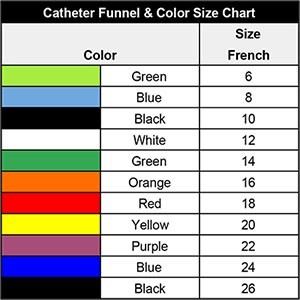The charge nurse brings a #18 urinary catheter with a 30 mL balloon to the practical nurse (PN) who is preparing to insert a catheter in a female client who weighs 50 kg. Which action should the PN take first?
Obtain a 30 mL syringe and a vial of sterile water.
Ask the client if she has previously been catheterized.
Consult with the charge nurse about the catheter.
Position the client and observe the urinary meatus.
The Correct Answer is C
This is the first action that the PN should take because the catheter size and balloon volume are inappropriate for the client. A #18 urinary catheter is too large for a female client who weighs 50 kg, and a 30 mL balloon may cause bladder trauma or discomfort. The PN should consult with the charge nurse and obtain a smaller catheter (such as #14 or #16) with a 10 mL balloon.

A. Obtaining a 30 mL syringe and a vial of sterile water is not the first action because it does not address the issue of the catheter size and balloon volume.
B. Asking the client if she has previously been catheterized is not the first action because it does not address the issue of the catheter size and balloon volume.
D. Positioning the client and observing the urinary meatus is not the first action because it does not address the issue of the catheter size and balloon volume.
Nursing Test Bank
Naxlex Comprehensive Predictor Exams
Related Questions
Correct Answer is B
Explanation
Choice A rationale:
Crushing the medication and administering it in applesauce might alter its pharmacokinetics, rendering it ineffective or causing it to act too quickly. Sublingual tablets are designed to dissolve under the tongue for rapid absorption into the bloodstream. Crushing the tablet and mixing it with applesauce could change its intended mode of action.
Choice B rationale:
Placing the tablet under the client's tongue is the correct action for a sublingual tablet. Sublingual administration allows the medication to dissolve directly into the bloodstream through the sublingual mucosa, bypassing the digestive system and providing rapid onset of action.
Choice C rationale:
Obtaining a liquid form of the medication might be an option, but it may not always be available. Additionally, some medications are not available in liquid forms, and the liquid form might have a slower onset of action compared to the sublingual route.
Choice D rationale:
Placing the tablet inside the client's cheek is known as the buccal route of administration. While this route is also for oral absorption, sublingual administration is preferred for specific medications designed for rapid absorption.
Correct Answer is ["A","C","D"]
Explanation
Whether you are a student looking to ace your exams or a practicing nurse seeking to enhance your expertise , our nursing education contents will empower you with the confidence and competence to make a difference in the lives of patients and become a respected leader in the healthcare field.
Visit Naxlex, invest in your future and unlock endless possibilities with our unparalleled nursing education contents today
Report Wrong Answer on the Current Question
Do you disagree with the answer? If yes, what is your expected answer? Explain.
Kindly be descriptive with the issue you are facing.
